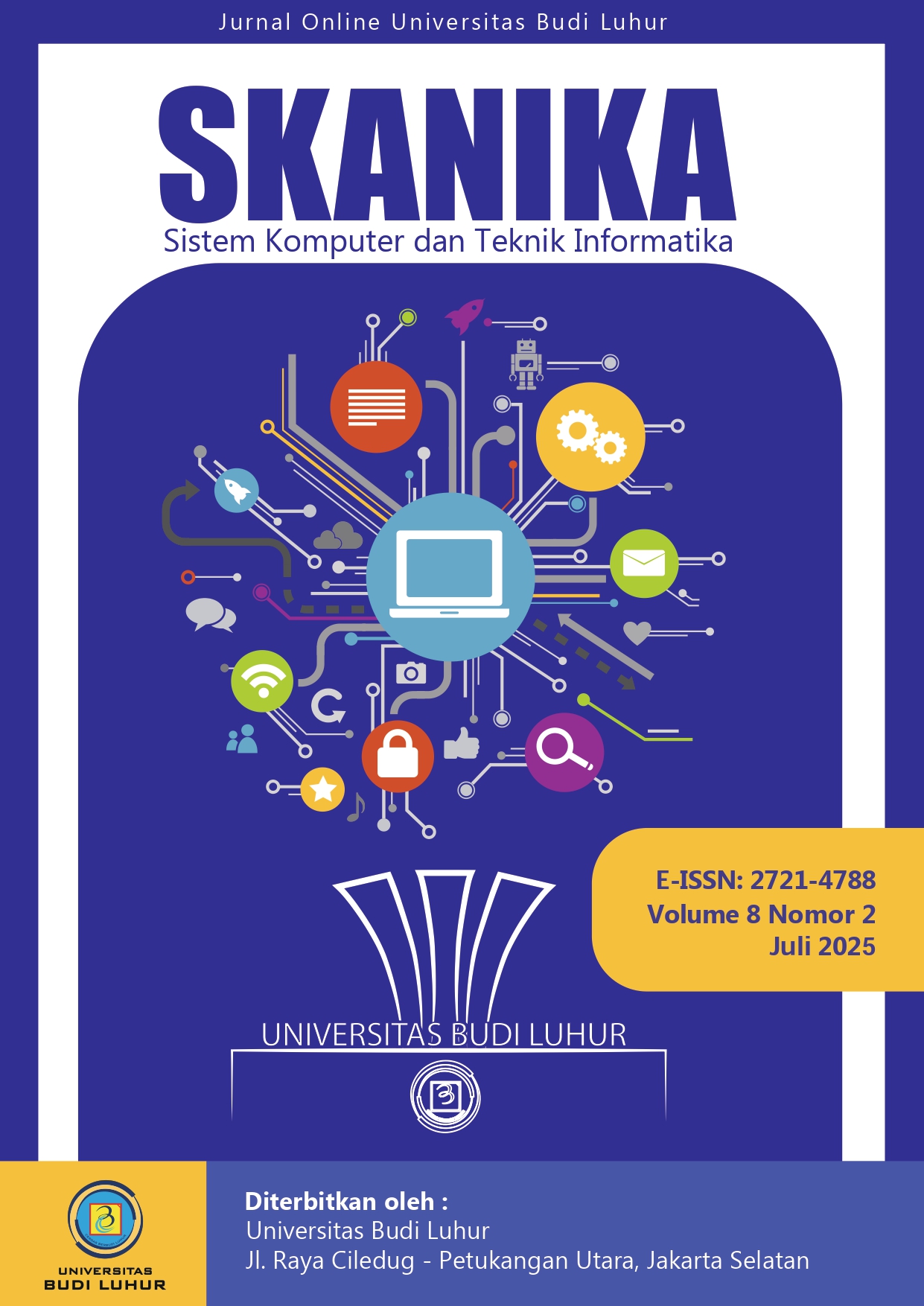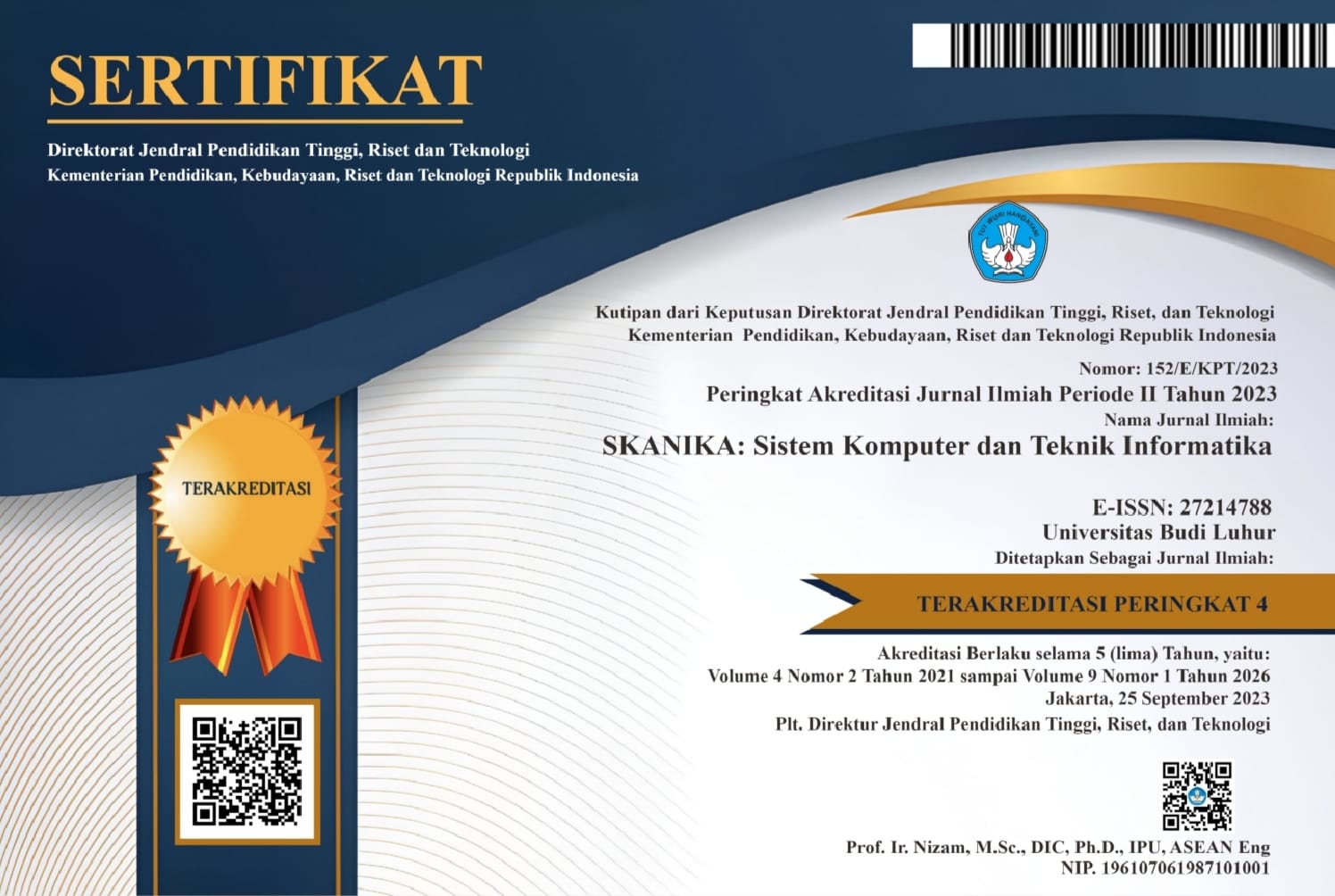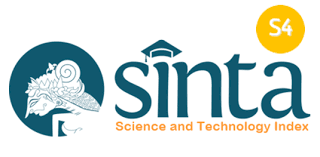KOMPARASI ALGORITMA KLASIFIKASI MACHINE LEARNING DENGAN PENERAPAN METODE ENSEMBLE STACKING UNTUK MENGANALISA SENTIMEN TERHADAP KESEHATAN MENTAL
DOI:
https://doi.org/10.36080/skanika.v8i2.3561Keywords:
Sentiment, Mental Health, Classification, StackingAbstract
Mental health often goes undetected due to the absence of physical symptoms, which hinders timely and appropriate intervention. Many individuals choose to express their emotions on social media rather than access professional services. However, the use of social media can potentially worsen mental health conditions and even impact physical well-being. Therefore, early detection through the analysis of digital data, particularly social media posts, using machine learning approaches is essential. Previous research on mental health sentiment analysis has utilized classification algorithms, but accuracy improvement remains necessary. This study compares single classification algorithms and applies an ensemble stacking method that combines multiple classifiers as base learners and a meta-learner. The results show that the stacking method achieves a higher accuracy of 88.13%.
Downloads
References
[1] Kementrian Kesehatan Republik Indonesia, “Hasil Riskesdas 2013,” Expert Opin Investig Drugs, vol. 7, no. 5, pp. 803–809, 2013, doi: 10.1517/13543784.7.5.803.
[2] Kemenkes, “Survei Kesehatan Indonesia 2023 (SKI),” Kemenkes, p. 235, 2023.
[3] N. Nurhayati et al., “Analisis Sentimen Komentar Youtube Terhadap Isu Kesehatan Mental Menggunakan Algoritma Naïve Bayes dan K-Nearest Neighbor (KNN),” Syntax: Computer Science and Information Technology, no. 6, pp. 8–16, 2025, doi: DOI:10.46576/syntax.v6i1.6060.
[4] J. R. Wiyani, I. Indriati, and S. Sutrisno, “Klasifikasi Stres berdasarkan Unggahan pada Media Sosial Twitter menggunakan Metode Support Vector Machine dan Seleksi Fitur Information Gain,” Jurnal Pengembangan Teknologi Informasi dan Ilmu Komputer, vol. 6, no. 12, pp. 6003–6009, 2022.
[5] K. D. Odja et al., “Mental illness detection using sentiment analysis in social media,” in Procedia Computer Science, Elsevier B.V., 2024, pp. 971–978. doi: 10.1016/j.procs.2024.10.325.
[6] M. Langgeng Wicaksono, R. Rusdah, and D. Apriana, “Analisis Sentimen Kesehatan Mental Menggunakan K-Nearest Neighbors pada Sosial Media Twitter,” Bit (Fakultas Teknologi Informasi Universitas Budi Luhur), vol. 19, no. 2, pp. 98–103, 2022, doi: 10.36080/bit.v19i2.2042.
[7] K. Rahayu et al., “Klasifikasi Teks untuk Mendeteksi Depresi dan Kecemasan pada Pengguna Twitter Berbasis Machine Learning,” MALCOM: Indonesian Journal of Machine Learning and Computer Science, vol. 3, no. 2, pp. 108–114, 2023, doi: 10.57152/malcom.v3i2.780.
[8] A. S. D. P. Sinaga and A. S. Aji, “Analisis Sentimen Publik Terhadap Mayor Teddy Indra Wijaya dengan Pendekatan Logistic Regression,” MALCOM: Indonesian Journal of Machine Learning and Computer Science, vol. 5, no. January, pp. 222–231, 2025, doi: https://doi.org/10.57152/malcom.v5i1.1752.
[9] D. R. F. Daud, B. Irawan, and A. Bahtiar, “Penerapan Metode Naive Bayes Pada Analisis Sentimen Aplikasi Mcdonalds Di Google Play Store,” JATI: Jurnal Mahasiswa Teknik Informatika, vol. 8, no. 1, pp. 759–766, 2024, doi: 10.36040/jati.v8i1.8784.
[10] A. Karim et al., “Anticipating impression using textual sentiment based on ensemble LRD model,” Expert Systems with Applications, vol. 263, no. August 2023, pp. 1-15, 2025, doi: https://doi.org/10.1016/j.eswa.2024.125717.
[11] K. Aziz et al., “Enhanced UrduAspectNet: Leveraging Biaffine Attention for superior Aspect-Based Sentiment Analysis,” Journal of King Saud University - Computer and Information Sciences, vol. 36, no. 9, p. 102221, 2024, doi: 10.1016/j.jksuci.2024.102221.
[12] C. Chulyatunni’mah R. Kurniawan and S. Anwar, “Analisis Sentimen Penggemar Treasure Di Karnaval Mandiri Menggunakan Naïve Bayes,” Jurnal Sistem Informasi Triguna Dharma (JURSI TGD), vol. 4, pp. 203–213, 2025, doi: https://doi.org/10.53513/jursi.v4i1.10606.
[13] L. Afuan, M. Khanza, and A. Z. Hasyati, “Peningkatan Analisis Sentimen Pelantikan Presiden Ri Tahun 2024 Pada X Menggunakan Naive Bayes Classifier Yang Dioptimalkan SMOTE,” Jurnal Teknik Informatika (JUTIF), vol. 6, no. 1, pp. 325–333, 2025, DOI: https://doi.org/10.52436/1.jutif.2025.6.1.4290.
[14] S. Syafrizal, M. Afdal, and R. Novita, “Analisis Sentimen Ulasan Aplikasi PLN Mobile Menggunakan Algoritma Naïve Bayes Classifier dan K-Nearest Neighbor,” MALCOM: Indonesian Journal of Machine Learning and Computer Science, vol. 4, no. 1, pp. 10–19, 2023, doi: 10.57152/malcom.v4i1.983.
[15] Y. Handayani et al., “Perbandingan Algoritma Logistic Regression Dan Naïve BAYES Classifier dalam Identifikasi Penyakit Liver,” Journal of Science and Social Research, vol. 8, no. 2, pp. 1435–1440, 2025, https://doi.org/10.54314/jssr.v8i2.2892.
[16] V. Vajrobol, B. B. Gupta, and A. Gaurav, “Mutual information based logistic regression for phishing URL detection,” Cyber Security and Applications, vol. 2, no. February, 2024, doi: 10.1016/j.csa.2024.100044.
[17] W. Ningsih et al., “Perbandingan Algoritma SVM dan Naïve Bayes dalam Analisis Sentimen Twitter pada Penggunaan Mobil Listrik di Indonesia,” MALCOM: Indonesian Journal of Machine Learning and Computer Science, vol. 4, no. 2, pp. 556–562, 2024, doi: 10.57152/malcom.v4i2.1253.
[18] T. Anderson, S. Sarkar, and R. Kelley, “Analyzing public sentiment on sustainability: A comprehensive review and application of sentiment analysis techniques,” Natural Language Processing Journal, vol. 8, no. June, p. 100097, 2024, doi: 10.1016/j.nlp.2024.100097.
[19] S. D. Wahyuni and R. H. Kusumodestoni, “Optimalisasi Algoritma Support Vector Machine (SVM) Dalam Klasifikasi Kejadian Data Stunting,” Bulletin of Information Technology (BIT), vol. 5, no. 2, pp. 56–64, 2024, doi: 10.47065/bit.v5i2.1247.
[20] S. Nauli et al., “Klasifikasi Kalimat Perundungan pada Twitter Menggunakan Algoritma Support Vector Machine,” JIPI: Jurnal Ilmiah Penelitian dan Pembelajaran Informatika, vol. 10, no. 1, pp. 107–122, 2025, https://doi.org/10.29100/jipi.v10i1.5749.
[21] P. K. Sari, R. R. Suryono. “Komparasi Algoritma Support Vector Machine dan Random Forest Untuk Analisis Sentimen Metaverse,” Jurnal MNEMONIC, vol. 7, no. 1, pp. 31–39, 2024.
[22] S. Nurohanisah, R. Astuti, and F. Muhammad Basysyar, “Deteksi Berita Palsu Menggunakan Algoritma Random Forest,” JATI: Jurnal Mahasiswa Teknik Informatika, vol. 8, no. 1, pp. 422–428, 2024, doi: 10.36040/jati.v8i1.8418.
[23] S. Sudarto, and K. Kusrini, “Klasifikasi Tsunami Gempa Bumi dengan Teknik Stacking Ensemble Machine Learning,”Jurnal Informatika Polinema, vol. 10. No.4 2024 doi:10.33795/jip.v10i4.5655.
[24] J. Prasetya, S. I. Fallo, and M. A. Aprihartha, “Stacking Machine Learning Model for Predict Hotel Booking Cancellations,” Jurnal Matematika, Statistika dan Komputasi, vol. 20, no. 3, pp. 525–537, 2024, doi: 10.20956/j.v20i3.32619.
[25] A. Daza, et al., “Stacking Ensemble Approach to Diagnosing the Disease of Diabetes,” Informatics in Medicine Unlocked, vol. 44, no. December 2023, 2024, doi: 10.1016/j.imu.2023.101427.
[26] Y. N. Fuadah, et al., “Optimasi Convolutional Neural Network dan K-Fold Cross Validation pada Sistem Klasifikasi Glaukoma,” ELKOMIKA: Jurnal Teknik Energi Elektrik, Teknik Telekomunikasi, & Teknik Elektronika, vol. 10, no. 3, pp. 728-741, 2022, doi: 10.26760/elkomika.v10i3.728.
[27] W. A. Firmansyach, U. Hayati, and Y. Arie Wijaya, “Analisa Terjadinya Overfitting Dan Underfitting Pada Algoritma Naive Bayes Dan Decision Tree Dengan Teknik Cross Validation,” JATI: Jurnal Mahasiswa Teknik Informatika, vol. 7, no. 1, pp. 262–269, 2023, doi: 10.36040/jati.v7i1.6329.
[28] F. R. Valerian et al., “Klasifikasi Tingkat Obesitas Menggunakan Metode GBM dan Confusion Matrix,” JATI (Jurnal Mahasiswa Teknik Informatika), vol. 9, no. 2, pp. 2242–2249, 2025.
[29] Y. N. Rumbia, “Perbandingan Metode KNN dan Naive Bayes untuk Klasifikasi Kelulusan Mahasiswa pada Mata Kuliah Probstat,” Jurnal PTI: Jurnal Pendidikan Teknologi Informasi, vol. 12, pp. 7–13, 2025, doi: 10.35134/jpti.v12i1.228.
Downloads
Published
How to Cite
Issue
Section
License
Copyright (c) 2025 Annisa Maulana Majid, Karina Imelda, Ismasari Nawangsih

This work is licensed under a Creative Commons Attribution-ShareAlike 4.0 International License.
CC BY-SA 4.0
Creative Commons Attribution-ShareAlike 4.0 International
This license requires that reusers give credit to the creator. It allows reusers to distribute, remix, adapt, and build upon the material in any medium or format, even for commercial purposes. If others remix, adapt, or build upon the material, they must license the modified material under identical terms.
BY: Credit must be given to you, the creator.
SA: Adaptations must be shared under the same terms.ng












